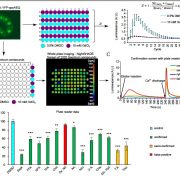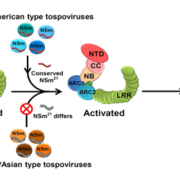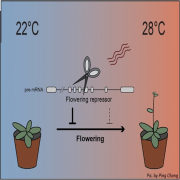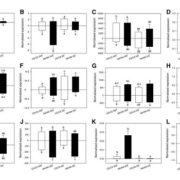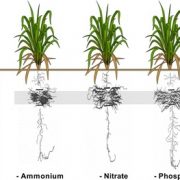Phosphatidic acid modulates MPK3- and MPK6- mediated hypoxia signaling in Arabidopsis (Plant Cell)
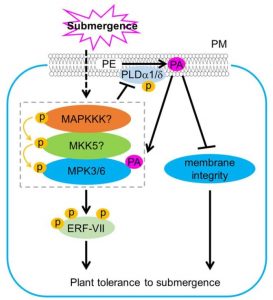 Plants experience changes in gene expression and cellular metabolism to improve their survival to abiotic stresses, such as hypoxia. It has been observed that environmental signals induce phospholipase D (PLD) which generates phosphatidic acid (PA) by cleaving membrane phospholipids. Indeed, submergence induces the accumulation of PA, however, the mechanisms underlying this response have been unknown. In this work, Zhou et al., propose a model based in the PA regulation of submergence tolerance by modulating the membrane integrity and MPK3/6-mediated hypoxia signaling. Submergence generates an accumulation of PA by inducing PLDα1 and PLDδ. PA binds MPK3/6 improving their performance which leads to the phosphorylation of ERFVII, such as RAP2.12, promoting their activities. At the same time, accumulation of PA increases ROS levels which threatens the plant survival. To tackle this harmful situation, MPK3/6 form a regulatory feed-back loop with PLDα1 and PLDδ to reduce their protein levels. In this way, PA is maintained at physiological levels for the plant to face long-term hypoxia conditions. This article sheds light into the mechanisms of hypoxia signaling by reinforcing the role of PA as a key lipid messenger in plant responses to abiotic stresses. (Summary by Eva Maria Gomez Alvarez, @eva_ga96) Plant Cell 10.1093/plcell/koab289
Plants experience changes in gene expression and cellular metabolism to improve their survival to abiotic stresses, such as hypoxia. It has been observed that environmental signals induce phospholipase D (PLD) which generates phosphatidic acid (PA) by cleaving membrane phospholipids. Indeed, submergence induces the accumulation of PA, however, the mechanisms underlying this response have been unknown. In this work, Zhou et al., propose a model based in the PA regulation of submergence tolerance by modulating the membrane integrity and MPK3/6-mediated hypoxia signaling. Submergence generates an accumulation of PA by inducing PLDα1 and PLDδ. PA binds MPK3/6 improving their performance which leads to the phosphorylation of ERFVII, such as RAP2.12, promoting their activities. At the same time, accumulation of PA increases ROS levels which threatens the plant survival. To tackle this harmful situation, MPK3/6 form a regulatory feed-back loop with PLDα1 and PLDδ to reduce their protein levels. In this way, PA is maintained at physiological levels for the plant to face long-term hypoxia conditions. This article sheds light into the mechanisms of hypoxia signaling by reinforcing the role of PA as a key lipid messenger in plant responses to abiotic stresses. (Summary by Eva Maria Gomez Alvarez, @eva_ga96) Plant Cell 10.1093/plcell/koab289


